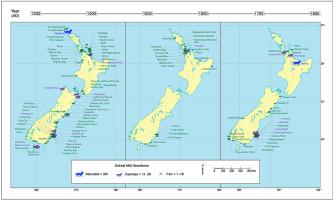Journal of Archaeological Science ( IF 2.8 ) Pub Date : 2022-02-01 , DOI: 10.1016/j.jas.2022.105556 Patricia Pillay 1, 2 , Melinda S. Allen 1, 2 , Judith Littleton 1

|
Globally, the place of dogs in the anthropogenic niche is varied, with dogs often tightly integrated into human communities, but sometimes pushed to the margins, and occasionally persisting as independent feral populations. Dog-human symbioses are correspondingly diverse, ranging from mutualistic to commensal to competitive. The Pacific Islands, and Polynesia in particular, offer a useful context in which to consider dog-human symbioses across varied socio-environmental settings. The translocation of domestic dogs across this oceanic region was underway more than two millennia ago, if not earlier, with dogs established on numerous Pacific Islands. However, occasionally dogs were subsequently extirpated, a situation often attributed to competition between dogs and their human managers. Here we focus on how the dog-human symbiosis shifted as colonists moved from the small, environmentally-circumscribed, islands of tropical central Polynesia, to the largest, most ecologically diverse landmasses in the region—the islands of Aotearoa New Zealand. We hypothesize that the mid-13th century settlement of Aotearoa New Zealand initially resulted in competitive release for Polynesian dogs (i.e., relaxation of competition with humans) but as large native prey were depleted, and human communities economically reorganised, dog-human competition arose anew. These two hypotheses are evaluated using: a) country-wide data on dog distributions and abundance over time; and b) a regionally focused analysis of dental markers relating to dog diet and health. Our results support the hypothesis of competitive release on entry to Aotearoa New Zealand; dogs were quickly distributed across the two main islands, onto many large offshore islands, and into varied ecological niches—where they were generally well represented and associated with human occupations. This situation appears to have been followed by interspecific competition midway through the Māori sequence (ca. AD 1450–1650), when both dog assemblages and dog abundances are poorly represented. From the mid-17th century, dog population rebound is suggested, possibly accompanied by new husbandry practices. These trends are not, however, well reflected in the regionally focused dental marker analysis, where good oral health and adequate nutrition are indicated. Published studies of dog coprolites and stable isotopes analyses help flesh out the dental analyses and point to avenues of future study. Our research gives new insights into variability in dog-human symbioses across the Pacific Islands and potentially elsewhere, with a particular focus on the conditions that give rise to competition and the value of multi-proxy analyses in unravelling these complex entanglements.
中文翻译:

犬类同伴或竞争对手?人狗竞争的多代理分析
在全球范围内,狗在人为生态位中的位置是多种多样的,狗通常紧密地融入人类社区,但有时被推到边缘,偶尔作为独立的野生种群持续存在。狗与人的共生关系相应地多种多样,从互惠到共生到竞争。太平洋岛屿,尤其是波利尼西亚,提供了一个有用的背景,可以在其中考虑跨不同社会环境环境的人狗共生关系。如果不是更早的话,两千多年前就已经开始在这个海洋地区转移家犬,在许多太平洋岛屿上建立了狗。然而,有时狗随后会被灭绝,这种情况通常归因于狗与其人类管理者之间的竞争。在这里,我们关注的是,随着殖民者从热带中部波利尼西亚的环境受限的小岛迁移到该地区最大、生态最多样化的陆地——新西兰奥特罗瓦岛,狗与人的共生关系如何转变。我们假设 13 世纪中叶新西兰 Aotearoa 的定居最初导致波利尼西亚狗的竞争性释放(即放松与人类的竞争),但随着大型本土猎物的枯竭和人类社区的经济重组,狗与人类的竞争重新出现. 这两个假设的评估使用: a) 全国范围内的狗分布和数量随时间变化的数据;b) 对与狗的饮食和健康相关的牙齿标记进行区域性分析。我们的结果支持进入新西兰奥特罗瓦时竞争性释放的假设;狗迅速分布在两个主要岛屿上,分布在许多大型近海岛屿上,并进入不同的生态位——它们通常在这些地方被很好地代表并与人类职业相关联。这种情况似乎在毛利人序列(约公元 1450-1650 年)的中期出现了种间竞争,当时狗的组合和狗的丰度都没有得到很好的体现。从 17 世纪中叶开始,狗的数量出现反弹,可能伴随着新的饲养方式。然而,这些趋势并没有很好地反映在以区域为重点的牙齿标记分析中,其中表明良好的口腔健康和充足的营养。已发表的关于狗粪化石和稳定同位素分析的研究有助于充实牙齿分析并指出未来研究的途径。


























 京公网安备 11010802027423号
京公网安备 11010802027423号